|
 |
|
In the latter part of the 19th
century, most of the local towns opened public
libraries, which were seen as a way of educating the
less well-off sections of society, teaching them to
live ‘a good and proper life’, so addressing the moral,
social and educational concerns of the time. This
became a reality thanks to the Public Libraries Act
1850 that gave local authorities the power to
establish free public libraries, providing free
access for everyone, to information and literature.
By the late 1870s, many people
thought that Tipton was lagging behind some of the
local towns by not having a free library. On 16th
March, 1877 a public meeting was held to discuss the
matter in the Police Court, Church Lane. It was
attended by Tipton ratepayers under the chairmanship
of James Whitehouse, Chairman of the Local Board of
Health. Those in favour of the adoption of the Free
Libraries Act included William Lees Underhill, who
proposed the adoption of the Act, and Thomas Davies who
seconded the proposal. A large majority of the
people at the meeting were in favour of the
proposal, which was carried by a show of hands.
Unfortunately nothing came of it because the
Local Board of Health decided at a meeting on 27th
June, 1880 that due to the depression at the time,
it was inappropriate to adopt the Act, because its
adoption would result in an increase in the rates.
Nothing happened until the
matter was discussed at another meeting of
ratepayers at the Police Court, on 24th March, 1883.
As at the previous meeting, the Chairman was James Whitehouse.
The setting-up of a free library was again proposed
by William Lees Underhill and seconded by James Solly of Great Bridge Ironworks and supported by
Peter D. Bennett, J.P., managing director of the
Horseley Works. The proposal was accepted by the
majority of people at the meeting and also accepted
by the Local Board of Health who decided to adopt
the Free Libraries Act.A Free Library Committee was
formed with the following members: James Whitehouse,
Chairman; Edward Bayley, Richard Mason, Henry Plant,
W. T. Travis, and Reverends S. T. Tozer and William
Cornwell. The first meeting was held on 9th June, 1884.
At a meeting in September, 1884, the committee received
a deputation from some of the most influential inhabitants of the town, including
Frederick T. Cox, James Solly, A. S. Underhill and
Peter Bennett, J.P., Managing Director of the
Horseley Works. They proposed that £1,000 should be
raised to help pay towards the rent for a suitable
building in the centre of the town that could be
used as a free library with a reading room. They
were told that if such a sum could be raised, some
of the members of the deputation would be co-opted
onto the committee to ensure that the money was
suitably spent. Although things seemed to get off to
a good start, nothing was done for several years.
Finally, in 1890
the decision was made to rent two rooms for use as
reading rooms, one at Horseley Heath, and another at
Toll End. £250 from the profits of the local gas
company was used to fund the project.
The room at
Horseley Heath was rented from a Mr. Clift at an
annual rent of £13, and the larger room at Toll End
was rented from Samuel Matthews at an
annual rent of £18. In the room at Horseley Heath
there were two tables, reading desks, and a gas
stove. At Toll End there were three tables, reading
desks, and a gas stove. Both rooms opened at 9
o’clock in the morning and closed at 9.30 in the
evening. The rooms were officially opened to the
public on 9th December, 1890, by Philip Stanhope,
MP. During the proceedings he expressed his
willingness to contribute £100 for the purchase of
books, if a permanent building could be found. |
|
The reading rooms were stocked
with the following newspapers and periodicals that
were supplied by newsagents Miss Ray and Mr. Meese: |
| |
Band of Hope |
British Workman |
| |
Cassel’s Magazine |
Chambers’ Journal |
| |
Daily Gazette |
Daily Mail |
| |
Daily News |
Daily Post |
| |
Express and Star |
Good Words |
| |
Illustrated London News |
Judy |
| |
Leisure Hour |
Midland Counties Express
|
| |
Punch |
Standard |
| |
Staffordshire Advertiser
Graphic |
Sunday at Home |
| |
Sunday Magazine |
|
|
|
Over the next few years,
reading rooms were established in the other four
wards, beginning with Tipton Green. In 1891, Mr.
Ryder planned to erect some buildings in Owen Street
and offered to allow one of the rooms to be used as
a reading room for seven years at a fixed rent. The
building would be opposite the shop owned by Daniel
Hipkins, Chairman of the Local Board and the Free
Library Committee. The plan was accepted, and the
new reading room, measuring 22 ft. by 30 ft. was
officially opened by Daniel Hipkins on 24th
February, 1892.
Other reading rooms soon
followed. The Dudley Port reading room opened in Oak
Terrace, and the Tibbington reading room opened at
Bloomfield. In 1894 the annual upkeep of the five
rooms was £195. Before 1894 was out, the Ocker Hill
reading room, rented from Mr. Higgins, opened at Lea
Brook. Each of the six wards, at last had its own
reading room.
|

Tipton Library in Victoria Road. From an old
postcard.
| Twelve years later, Tipton
finally got a proper library. The Public Library was
a gift from Andrew Carnegie, the Scottish born
American historian and philanthropist. It stands in
Victoria Road, next to the junction of Mayfair
Gardens. |
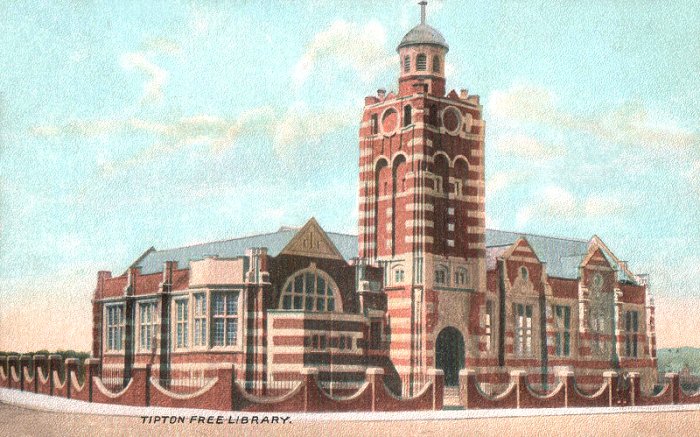
From an old postcard.
|
It was designed by George H.
Wenyon and built in 1905 of red brick with bands of
yellow terracotta and a tile roof. It is a single
storey building with a tower that has corner
buttresses and a domed lantern. It was opened in
1906 by Councillor William Woolley Doughty, who was
later Chairman of Tipton Urban District Council. The
library was well stocked and had several reading
rooms including an adult library, a junior library,
and a children’s library. The building was Grade II
listed in February 1982. It closed in 2000 when the
new Tipton Library in Unity Walk was built. The old
library
reopened as Sandwell Council’s Occupational Health
Unit. On 30th May 2006 it became the Tipton Carnegie
Centre.
|
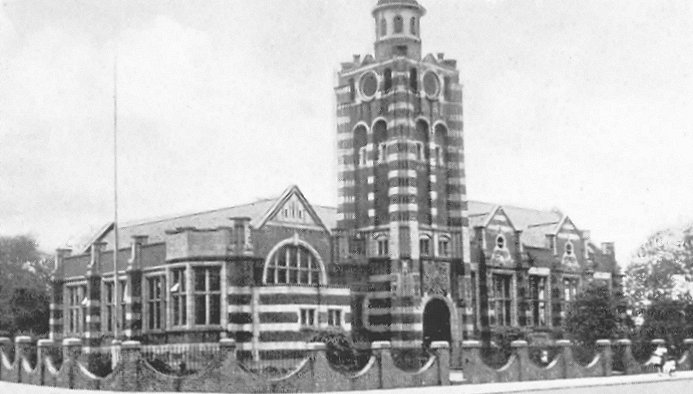
Another view of the library.
|
In 1907 the Toll End Branch
Library, in Toll End Road opened. It was also a gift
from Andrew Carnegie. Another library, Glebefields
Branch Library in St. Marks Road opened on 1st
January, 1973 and is still in use today.
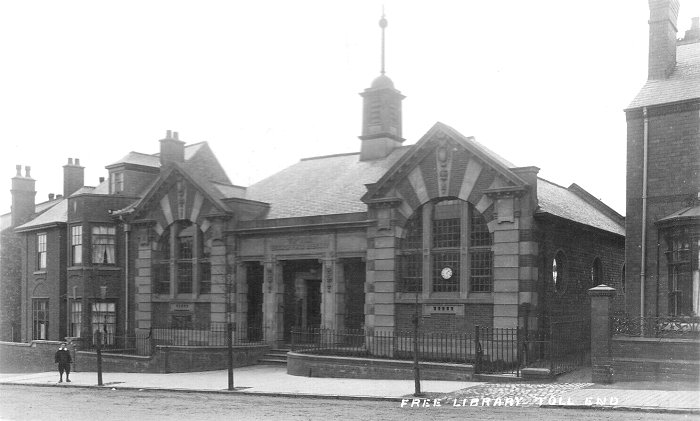
Toll End library. From an old
postcard.
Tipton’s library moved to Owen
House in Unity Walk on the 29th November, 2000. It
was officially opened by the
Mayor of Sandwell, Councillor Mrs Jean Marson. The
new and much larger library included Tipton Heritage Centre, where items
of historical interest were on display. The Heritage
Centre opened in September 2006.
The new library was in rented
property and in order to save over £60,000 annually,
Sandwell Council decided to end their tenancy agreement
and move the library back to the much smaller Carnegie
building in Victoria Road, which reopened in May 2024.
|

The entrance to Owen House in Unity Walk.
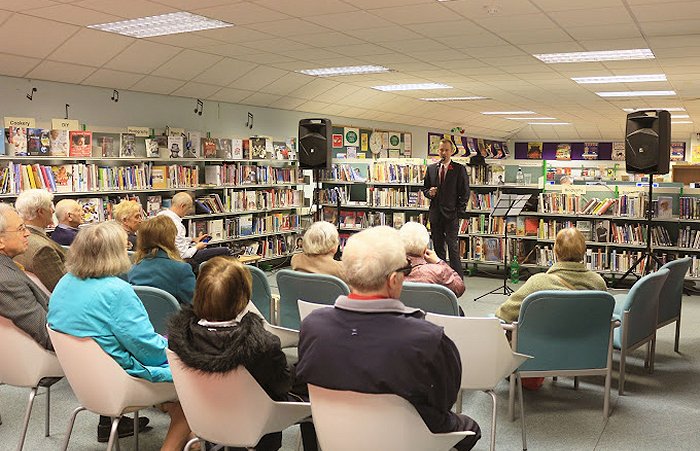
Tom Heyes performing in Owen House.
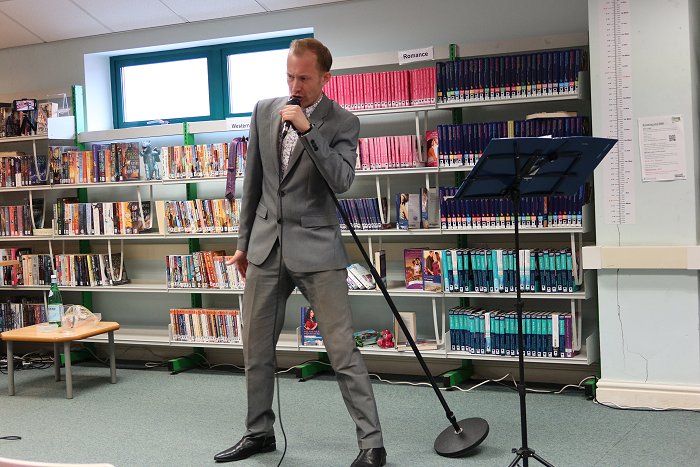
Tom Heyes performing at Owen House in May 2023.
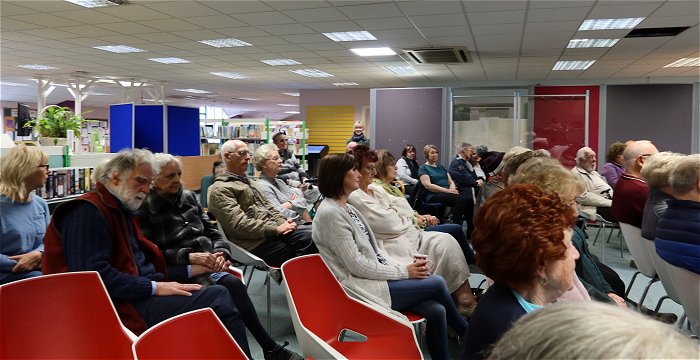
Some of the people watching Tom Heyes perform
at the library in May 2023.
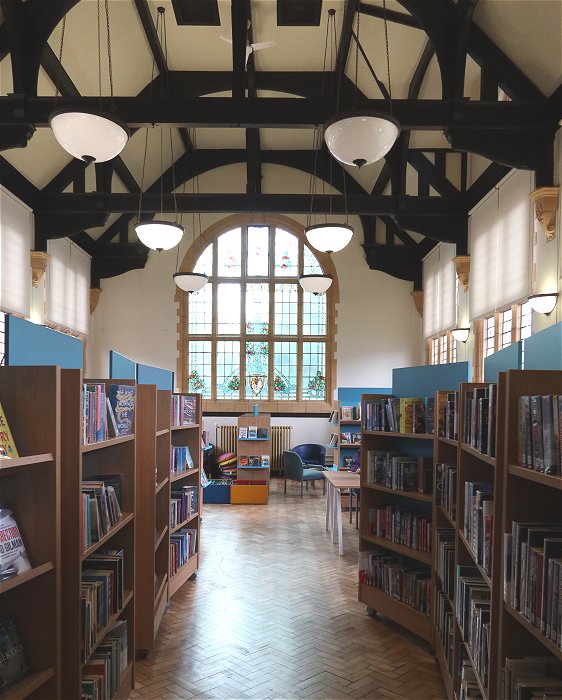
The new library in Victoria Road.
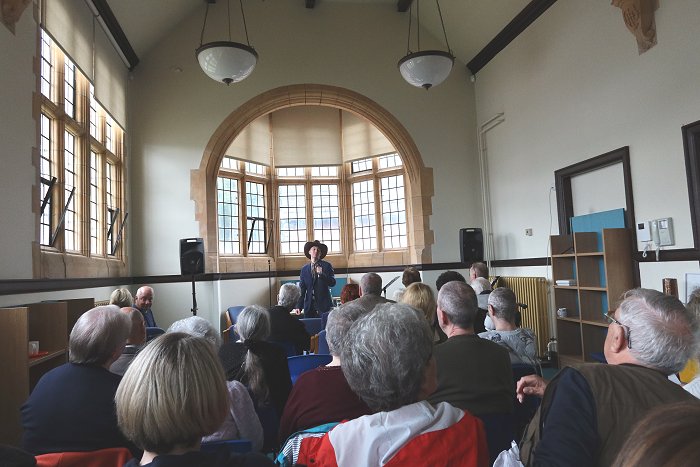
Tom Heyes performing in the Carnegie building.

A final view of the library in Victoria
Road. From an old postcard.
 |
Return to
the
previous page |
|